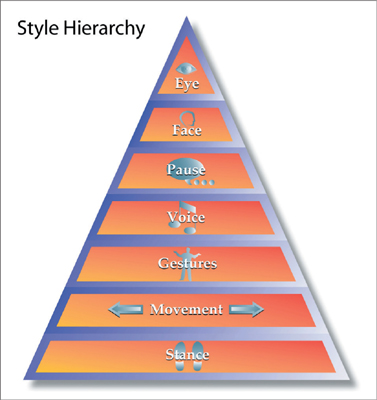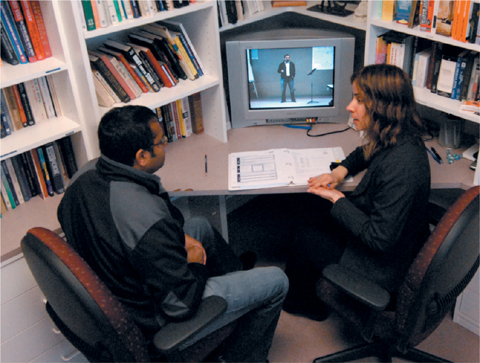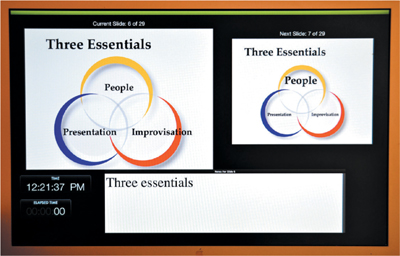CHAPTER
13
Delivery Style

George Gleeson
Don’t make yourself the lead actor in this play. You’re not. Go in there and quickly, concisely deliver the information, answer questions, survive it, and get out.
—George Gleeson, Regional Sales Manager,
Enterprise Hardware, Oracle
When you deliver your “New Employee Orientation” or your “All Hands Meeting,” strong style is a must. You can even be charismatic. However, when you hit the C-level, the executives are just interested in getting business done, and are less interested in charisma. It’s not about how you deliver your proposal, but rather about the proposal itself.
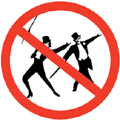
Ned Barnholt reported seeing a particularly poor presenter who simply turned to the screen and read his slides to senior management at Agilent. “Content-wise it was a very interesting idea, and I’m willing to overlook the shortcomings of the presentation in order to focus on this opportunity.”

Ned Barnholt
Now let’s be clear, executives do not want a poor presenter. What they do want is excellent content—and oh, by the way, if the presenter is also a good speaker, that is a real plus. If your style needs an upgrade, a good place to start is with our Style Hierarchy.
Style 101: Signal-to-Noise Ratio
Content without style goes unnoticed, and style without content has no meaning.
—Michael Alley
Professor of Mechanical Engineering,
Penn State
The “Style Hierarchy” is a way to conceptualize “The Big Seven” of style. In person, stand-up presentations to any group will involve all of these behaviors. The question is, “How aware are you of what you are doing in each area?”
While executives are most interested in your content, if you have poor delivery, it will make it harder for them to be persuaded by what you are saying. A speaker who mumbles, paces, fidgets, talks in a monotone, talks too fast without pauses, and won’t make eye contact with the audience is seen as nervous and just not believable.
The question is, are you conscious of what you are doing with your body as you deliver your message? Most speakers are completely clueless about the physical part of their delivery. They are too nervous to think about it. When people get nervous, the fidgeting and hand wringing start up, and boom! There goes the value of the message.
The good news is that fixing this is easy. If your style needs a tune-up, take a class. Make sure the class includes video feedback and private coaching. You will improve your skills in no time. But, keep in mind, your content matters more than your delivery. The main reason to polish up your delivery is so people can hear your message more clearly.
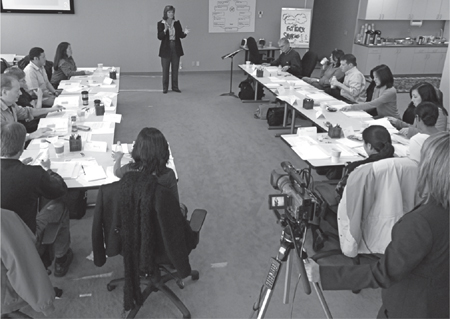
Classroom
Think of a rocket putting a satellite into orbit. The rocket provides the thrust and power, but it is only the vehicle. What is important is the satellite. Same thing with your presentation. It is the message that counts. But your style is what puts it “in orbit.” Or, borrowing from electrical engineering, the concept of “signal-to-noise ratio” is helpful here. Think of a radio with static. You are interested in the music, not the static. A strong signal will deliver the music. A weak signal will have a lot of distracting static. So, too, with your presentations. A weak presenter who may have great content, but is plagued with nervous mannerisms, will not get his or her message across. The strength of the signal is ruined because of the noise of the poor style. Put another way, poor delivery style can ruin good data!
Until you can take a video-based class, here is a crash course on style.
Eye Contact
When I was a senior in high school, my speech teacher, Mr. Ellers, told us, “Look above their heads. It will make you too nervous to look in their eyes.” Or a variation on that, “Look at their forehead.” Or, “Look at the back wall.” Or, my personal favorite, “Imagine the audience in their underwear.” Now, how that will make you feel more relaxed is beyond me. In fact, it could make you forget your content altogether. Of course, it’s all total nonsense.
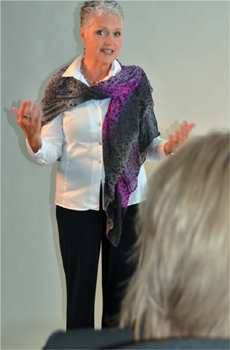
Eye contact
To connect with people and drive home your message, you need to look them squarely in the eyes. Select people randomly around the room. Hold eye contact with one person for a complete thought, then move on.
The meaning of eye contact, though, can have various cultural connotations. In Western cultures, eye contact is a sign of confidence and credibility, while in some other cultures it can be a sign of disrespect, or even of challenge. In some Japanese business cultures, for example, senior leaders will listen to a presenter with their eyes closed which says, “We trust what you are saying,” or, “We are listening carefully to what you are saying.” If you did not know this, it could be very disconcerting.
Facial Animation
By the time you get far enough up the chain to be addressing a senior-leadership meeting, you are undoubtedly enthusiastic about what you are presenting. Executives told us again and again, they want to see that enthusiasm, but not a lot of rahrah. Use your face to communicate your excitement about your topic. Don’t be afraid to be animated: eyebrows up for good news as you are smiling, and the furrowed brow for serious issues, etc.
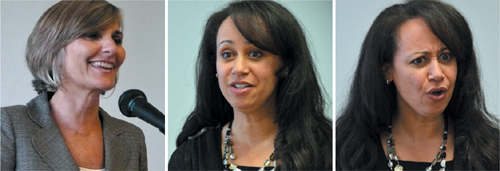
Facial animation
Pause
As if trying desperately to end this torture as soon as possible, nervous speakers talk too fast and never pause. On the other hand, speakers eager to connect with their audiences will use pauses to let their ideas sink in. The pause is often accompanied by longer eye contact and the holding of a gesture. Pauses under two seconds don’t register. Three to four seconds, and it really hits home. Nine or ten seconds, they call 911.
Vocal Variety
Sergeant Friday from the old Dragnet TV show used to advise hysterical witnesses, “Just the facts ma’am. Just the facts,” always in a total monotone. We see too many speakers who are doing their best imitation of Joe Friday. They think they should present “just the facts” in a boring monotone. They mistakenly think the monotone increases their credibility, and that enthusiasm decreases their believability. Just the opposite is true. Recent research from MIT indicates that, in fact, vocal variety and animation increase rather than decrease your credibility.
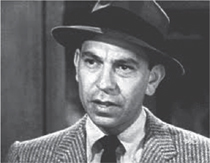
Joe Friday
Photo courtesy Moviecraft, Inc.
Believe it or not, your facial expression affects your voice. To make your voice sound brighter and more inviting, try smiling as you speak. Conversely, it is very hard to sound cheerful when you are frowning.
Gestures
Nervous speakers, if they gesture at all, often keep their hands clasped in front of their bodies, as though protecting themselves. It says to the audience, “I’m not sure of myself.” It makes the audience doubt the speaker’s confidence and credibility. Confident, persuasive speakers use bold gestures. They take up space and seem to be comfortable in their own skin. Use gestures effectively and your audience will not even be aware of your gestures. They will, however, be aware of how congruent you are with your message. Effective style is invisible. It’s a total package. (Pentland’s MIT research confirms that animation increases believability.)

Nervous gesture
Rule of thumb: when gesturing, bring your hands up above your waist and out away from your body. While using both hands, or what we call “bilateral gestures,” can look good, what looks even better is what we call “unilateral gestures,” meaning that one hand gestures while the other is relaxed at your side or in your pocket.

Bilateral gesture
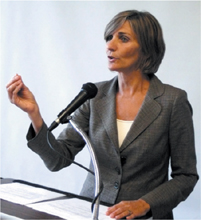
Unilateral gesture
Gestures are one of your most powerful communication tools. Use them to help your audience get the meaning visually of what your words are saying. Be descriptive. For example, to show sales growth, move your hand “up and to the right.” In essence, to look and feel confident, let your hands and arms reflect what your words are saying.
The Pocket Myth
Speaking of pockets, you may have heard that you should never put your hands in your pockets. Again, my high school speech teacher, dear old Mr. Ellers, used to admonish students that hands in the pockets made them “look too casual.” With all due respect to Mr. Ellers, that is just not a problem. In fact it is an asset. Notice how often in the media you will see a relaxed, confident speaker with one hand in the pocket. It does indeed make you look casual, and guess what? That is just how effective speakers feel in front of the room. If the speaker looks relaxed and not nervous, the audience gets a sense of the speaker’s confidence and hence, believability.
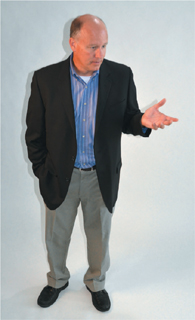
Use of the pocket
Movement
You will see nervous speakers either pacing back and forth in front of the room, or just the opposite, standing rigidly in one spot like a lamp post. Moving naturally with the flow of your content says nonverbally that you are relaxed and confident, and that you want to connect with people in different parts of the room.
Let your content guide your movement. You might, for example, set up your First Line, Bottom Line, ROI, and agenda in the center of the room, then move to the right to develop your first key point, to the left for your second key point, and finally back to the center for your conclusion. Just be sure to avoid looking like a caged tiger or a statue.
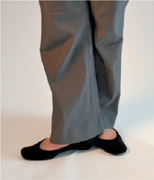
3rd position
Stance
Stance is at the bottom of our “Style Hierarchy” because it is the foundation of strong delivery. Nervous speakers demonstrate all manner of odd stances: shifting from one foot to the other, rocking back on one heel, rocking up on one foot, or my favorite—left over from childhood ballet lessons—the dreaded “third position,” where the feet are held close together with one pointing out at a 90-degree angle to the other. This is often accompanied by a high voice and hands clasped tightly in front of the body. A stance like this says, “Don’t take me seriously.”
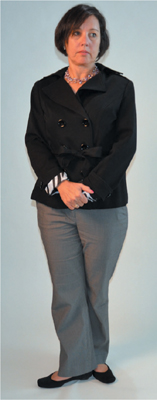
Stance disaster
A more credible stance is like a solid athletic stance. Feet are about hip-width apart, firmly connected to the floor, and pointed straight ahead. When the speaker moves to one side or the other, the feet are replanted in the new position.
Don’t Sit at the Table!
During the video production of Speaking Up®, we were surprised at the strength of the executives’ negative reactions when Sharon Black sat at the table to make her presentation. They felt she had violated their space. One executive commented, “Seats at the table are for the senior-leadership team. The presenter should stand at the front of the table, not sit.”
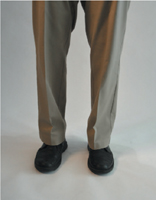
Solid stance
Visual Aids
It’s like having clothes on. People feel naked if they don’t have slides.
—Vern Kelley
Presenters seem to think we are just PowerPoint receptor machines.
—Felicia Marcus
It’s not ‘show and tell.’ Just answer the questions without putting up another chart. Just look me in the eye, and say, ‘John, the answer is 6.’
—John Kispert
Depending too much on visual aids, or worse, reading them, can be career limiting in front of senior leadership. Slides are your backup. They’re tools to bolster your argument. They cannot be your argument. Ironically, Steve Ballmer, the CEO of Microsoft, the company that makes PowerPoint, famously advised a presenter, “Please, don’t show me the deck.”
If you are a senior leader in a Fortune 500 company, you have seen perhaps 100,000 slides shown by hundreds of presenters over the years. John Kispert said, “There are weeks when I sit through over 100 presentations.” Just imagine how mind-numbing that would be if every one of those presenters comes armed with, say, 10 to 20 slides.
The executives we interviewed were universal in their dislike of slide shows from subordinates. Ned Barnholt commented that he simply could not trust a presenter’s depth of understanding if he or she could not speak without slides. Dan Eilers said, “The most powerful slide is no slide, because slides numb the mind.”
What these executives want is a discussion, not a slideshow. Following the “10/30 Rule,” if you prepare for just 10 minutes of content and figure three minutes per slide, you will need only three slides for a 30-minute presentation. Do have backup slides, though, in case they want to drill down.
Anna Eshoo commented emphatically, “I don’t have time for a PowerPoint presentation!” She went on to describe a visual aid fiasco when General David Petraeus buried a congressional delegation with PowerPoint slides in order to avoid confronting the issues they came to talk about:
The main purpose of our visit was to learn when we could bring the troops home. He said ‘Hello.’ We sat down in his office, and he immediately began with a PowerPoint presentation. And it went on and on and on.
I had two takes on that PowerPoint presentation: (a) this was an insult to this Congressional delegation, who came here to talk about very specific, serious, profound questions, and (b) that he was playing Beat the Clock, thinking “I’m going to use up all of the time with a PowerPoint presentation, and then look at the clock and say, ‘You know what, I’m sorry. I’ve got to go and meet with the troops now. Nice to see you. God bless you and God bless America,’ and hightail it out of there.”

General David Petraeus
He had to be stopped by the leader of the delegation who said: ‘General, we appreciate this, but we’ve traveled halfway across the world to meet with you, to get the answers to the following questions …’ Petraeus didn’t like that. He’s accustomed to doing exactly what he wants to do.
If someone thinks that they’re going to dazzle a top leader simply with a PowerPoint presentation, they’re mistaken. It can be deadly.
A Visual Aid Horror Story
Brenda Rhodes recalled the dangers of over-reliance on the computer and PowerPoint slides:
I was part of a three-person panel. The computer crashed during the presentation of the speaker before me, and he died with it. He had his entire outline on his PowerPoint, and couldn’t do his presentation without the computer. The audience watched him literally sweat—the beads of sweat dropping on the computer—as he tried to get it to work and couldn’t. He threw out some summaries and that was the end of it.
Brenda was able to do her presentation without the PowerPoint. She advises, “Don’t ever put yourself in a position where you can’t just stand and present without visual aids. Know your presentation well enough to do that.”
But, in the event you do have to use PowerPoint, here are some quick tips for your slide presentation, not just for executives, but for any audience.
Slide Content and Delivery
Research from Richard Mayer2 at the University of California, Santa Barbara, Michael Alley3 at Penn State, and Edward Tufte4, former Yale professor of statistics, proves that word slides are the least effective way to get your message across. All of these researchers argue for more graphical content on slides: color charts, photos, diagrams … whatever would support your message nonverbally.
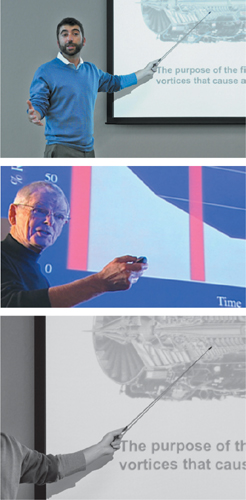
Tips For Slide Delivery:
• Stand next to the screen, not at the computer. This says, “I’m fully engaged in what I’m presenting.”
• Use a remote mouse to advance your slides. This gives you freedom to move around the room and not be tied to your computer.
• Use a mechanical pointer. Laser pointers are popular because they seem cool. Actually most audiences don’t like them. In an informal survey, we asked a presenter to do the same presentation in three different ways: pointing to the screen with his hand, pointing with a mechanical pointer, and pointing with a laser. Of the 50 people in the audience, all 50 preferred the mechanical pointer. Several were adamant that they hated the laser pointer.
• Use the dual screen/notes function on your computer. Today’s visual aid software in both the Mac and the Windows environments allows you to control your image flow as never before. Your audience will see only the slide you want them to see, while you can see the next slide coming. Also, with the notes section at the bottom of the page, you can simply glance down and get an idea or statistic quickly without fumbling through notes.
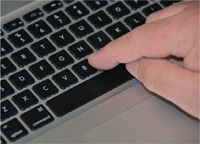
• Use the ‘B’ key. In slide show mode in both Keynote and PowerPoint, the ‘B’ key on your computer keyboard makes the screen go blank. Press it once to blank the screen, press it again to bring back the image.
There are three benefits to doing this:
1. It creates a “pattern disruption” event which refreshes the brains of your audience members.
2. It draws their attention back to you.
3. It says to the audience, “This conversation is between us; it is not about reading slides.”
If you act on nothing else I’ve recommended in this chapter, do this. Using the ‘B’ key marks you as a pro.
Whether using word slides or graphics, keep the content big and bold. Your busy, multitasking audiences have zero interest in working hard to decipher what’s in your slides. As reported in Fortune Magazine,5 venture capitalist Vinod Khosla has what he calls the “Five Second Rule.” Khosla shows a slide for five seconds, turns it off and asks the viewer what it was about. If the viewer can’t recall, the slide is a failure.

Corinne Nevinny
Finally, send slides in advance. This is not only an important part of the preparation; it can also be strategic. As Corinne Nevinny observed, “Send your slides out before the meeting. It prevents the meeting from being a ‘free-for-all.’ Most people won’t read what you send them, and if they feel unprepared, they are less likely to attack your idea.”
Summary
If you speak infrequently, chances are you don’t think much about your delivery. Most people who take our training programs are unaware of how they look when they present. Usually their delivery hurts their content because they look nervous, which, as we’ve seen, creates doubt in the audience’s mind regarding their mastery of the topic. The good news is that style is easy to master. Nervous, fidgety delivery can easily be fixed by taking a video-based training program and/or getting private coaching. In the meantime remember:
• Look ‘em directly in the eyes.
• Use long pauses and lots of vocal variety.
• Use descriptive gestures that are up and out, away from your body.
• To own your space, move with purpose at transitions in your presentation, then plant your feet.
• Keep visual aids to a minimum, but when you do use them, stand next to the screen and point to what you are talking about with a mechanical pointer. (Avoid the laser.) Use the ‘B’ key to shift focus and to increase your interaction with the audience.

